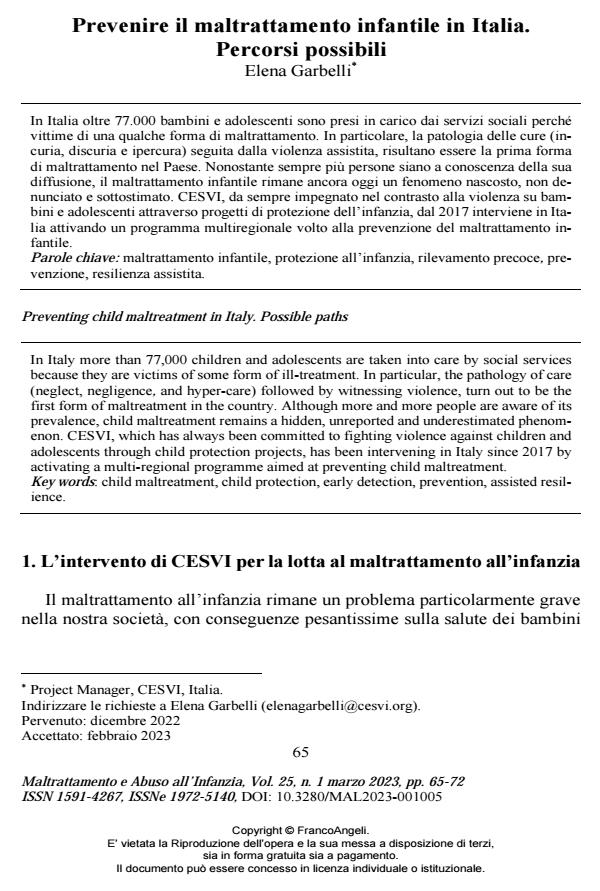Preventing child maltreatment in Italy. Possible paths
Journal title MALTRATTAMENTO E ABUSO ALL’INFANZIA
Author/s Elena Garbelli
Publishing Year 2023 Issue 2023/1
Language Italian Pages 8 P. 65-72 File size 168 KB
DOI 10.3280/MAL2023-001005
DOI is like a bar code for intellectual property: to have more infomation
click here
Below, you can see the article first page
If you want to buy this article in PDF format, you can do it, following the instructions to buy download credits

FrancoAngeli is member of Publishers International Linking Association, Inc (PILA), a not-for-profit association which run the CrossRef service enabling links to and from online scholarly content.
In Italy more than 77,000 children and adolescents are taken into care by social services because they are victims of some form of ill-treatment. In particular, the pathology of care (neglect, negligence, and hyper-care) followed by witnessing violence, turn out to be the first form of maltreatment in the country. Although more and more people are aware of its prevalence, child maltreatment remains a hidden, unreported and underestimated phenomenon. CESVI, which has always been committed to fighting violence against children and adolescents through child protection projects, has been intervening in Italy since 2017 by activating a multi-regional programme aimed at preventing child maltreatment.
Keywords: child maltreatment, child protection, early detection, prevention, assisted resilience.
- Bringiotti, M. I., Krynveniuk, M., & Lasso, S. (2004). As mùltiplas violências da ‘violência’ na escola. Desenvolvimento de um enfoque teo ́rico e metodòlogico integrative [The violence of multiple “violence” in school. Developing an integrative theoretical and methodological approaches]. Paidéia, 14, 313-325. DOI: 10.1590/S0103-863X2004000300007
- Bronfenbrenner, U. (2010). Ecologia dello Sviluppo umano. Bologna: il Mulino.
- Chan, Y. C., Lam, G. L., Chun, P. K. R., & So, M. T. E. (2006). Confirmatory factor analysis of the Child Abuse Potential Inventory: Results based on a sample of Chinese mothers in Hong Kong. Child abuse & neglect, 30(9), 1005-1016.
- de Paùl, J., Arruabarrena, M. I., Mûgica, P., & Milner, J. S. (1999). Validaciün de una versiòn Española del Child Abuse Potential Inventory [Validation of a Spanish version of the Child Abuse Potential Inventory]. Estudios de Psicologìa, 20, 55-72. DOI: 10.1174/02109399960256766
- de Paùl, J., Asla, N., Pérez-Albéniz, A., & de Càdiz, B. (2006). Impact of stress and mitigating infor- mation on evaluations, attributions, affect, disciplinary choices and expectations of compliance in mothers at high and low risk for child physical abuse. Journal of Interpersonal Violence, 21, 1018-1045. DOI: 10.1177/0886260506290411
- de Paùl, J., Pérez-Albéniz, A., Ormaechea, A., Vergara, A., & de Càdiz, B.T. (2006). Aggression inhibition in high- and low-risk subjects for child physical abuse: Effects of a child’s hostile intent and the presence of mitigating information. Aggressive Behavior, 32, 216-230.
- Grietens, H., De Haene, L., & Uyttebroek, K. (2007). Cross-cultural validation of the Child Abuse Potential Inventory in Belgium (Flanders): Relations with demographic characteristics and parenting problems. Journal of Family Violence, 22(4), 223-229.
- Jakupĉevic ́, K. K., & Peĉnik, N. (2011). Risk factors of child physical abuse by parents with mixed anxiety-depressive disorder or posttraumatic stress disorder. Croatia Medical Journal, 52, 25-34.
- Jong, J. (2002). Ongezondheid van de ouder & potentie ̈le fysieke kindermishandeling: Een correlationeel onderzoek binnen consultatiebureaus naar de samenhang tussen de ongezondheid van de ouder en potentie ̈ le fysieke kindermishandeling [Ill health of the parent and child abuse potential: A correlational clinical study of the association between the unhealthiness of the parent and child physical abuse potential]. Unpublished master’s thesis. Amsterdam, Netherlands: Vrije Universiteit.
- Keuning, M., Schulze, H., Stams, G. J., Groenewegen, I., & Schuengel, C. (2002). Marital conflict strategies predict child abuse potential in Dutch families from low socioeconomic backgrounds. Zeitschrift für Familienforschung, 14, 153-166.
- Milani, L., & Gagliardi, G. (2013). Fattori di rischio e di protezione nella valutazione delle competenze parentali di famiglie italiane e famiglie immigrate. Maltrattamento e Abuso all’Infanzia, 15(1), 59-80.
- Milani, L., Grumi, S., Camisasca, E., Miragoli, S., Traficante, D., & Di Blasio, P. (2020). Familial risk and protective factors affecting CPS professionals’ child removal decision: A decision tree analysis study. Children and Youth Services Review, 109, 104687.
- Milner, J. S. (1986). The Child Abuse Potential Inventory: Manual (2nd Ed.). Webster, NC: Psytec.
- Milner, J. S. (1994). Assessing physical child abuse risk: The Child Abuse Potential Inventory. Clinical Psychology Review, 14, 547-583. DOI: 10.1016/0272-7358(94)90017-5
- Milner, J. S., & Crouch, J. L. (1999). Child maltreatment evaluations. International Journal of Child & Family Welfare, 4, 6-23.
- Milner, J. S., Gold, R. G., Ayoub, C. A., & Jacewitz, M. M. (1984). Predictive validity of the Child Abuse Potential Inventory. Journal of Consulting and Clinical Psychology, 52, 879-884. DOI: 10.1037/0022-006X.52.5.879
- Miragoli, S., Camisasca, E., & Di Blasio, P. (2015). Validation of the Child Abuse Potential Inventory in Italy: A preliminary study. SAGE Open, 5(3), 1-11. DOI: 10.1177/2158244015597044
- Miragoli, S., Camisasca, E., Di Blasio, P., Milani, L., Ionio, C., Gizzi, N., Cammarella, A., & Malagoli Togliatti, M. (2016). Child Abuse Potential Inventory in Italy: A comparative study of abusive and non-abusive parents. Journal of Child Custody, 13(4), 289-306. DOI: 10.1080/15379418.2016.1250145
- Montes, M. P. M., de Paùl, J., & Milner, J. S. (2001). Evaluations, attributions, affect, and disciplinary choices in mothers at high and low risk for child physical abuse. Child Abuse & Neglect, 25, 1015-1036. DOI: 10.1016/S0145-2134(01)00254-X
- Rios, K. S. A. (2010). Inventàrio de Potencial de Abuso Infantil- CAP: Adaptaçã o transcultural, confiabilidade e validade para o Brasil [Child Abuse Potential Inventory - CAP: Transcultural adaptation, reliability and validity for Brazil]. Unpublished doctoral dissertation. São Carlos, Brazil: Universidade Federal de São Carlos.
- Terres des Hommes e CISMAI (2021). Maltrattamento dell’infanzia: i dati della seconda indagine nazionale di Terre des Hommes e CISMAI. -- (Disponibile online: https://terredeshommes.it/comunicati/maltrattamento-dellinfanzia-dati-della-seconda-indagine-nazionale-terre-des-hommes-cismai/).
- Dinamiche della parentificazione e morfogenesi post-traumatica: cPTSD e DTD Massimiliano Fierro, Elena Acquarini, in MALTRATTAMENTO E ABUSO ALL'INFANZIA 3/2024 pp.113
DOI: 10.3280/MAL2024-003006
Elena Garbelli, Prevenire il maltrattamento infantile in Italia. Percorsi possibili in "MALTRATTAMENTO E ABUSO ALL’INFANZIA" 1/2023, pp 65-72, DOI: 10.3280/MAL2023-001005